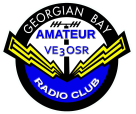2021-09-07, 10:13:20
I enjoy operating portable - out in the field - and use either a wire antenna supported by trees or, in the absence of suitable trees, a vertical antenna.
A ground-mounted vertical antenna needs a lot of radials to make it efficient, but if the antenna feed point is raised above ground fewer radials are required to obtain the same efficiency.
Operating out in the field makes it very difficult to deploy a lot of radials so a single raised counterpoise is often used. The counterpoise must be one quarter of a wavelength long. The vertical element is also one quarter of a wavelength long so the combination is similar to a half-wave dipole that is bent at 90 degrees at the feed point. It works very well; I have made many contacts with such an arrangement.
There is a problem though. The physical footprint of a vertical antenna is very small, but when we add a raised counterpoise - which for the 40m band is 33 feet long - we need a lot more space. But there is a solution - a spiral counterpoise.
A spiral counterpoise is loosely based on the Petlowany coil antenna. It is a disc holding a well-spaced coil of wire, one quarter wavelength long, in a horizontal plane. My spiral counterpoise holds 33 feet of wire in a disc with a diameter of just two feet, mounted at the base of the vertical element.
I used a sheet of 1/8 inch thick MDF drilled with lots of holes through which the wire is threaded in basket-weave fashion. It is lightweight, yet rigid enough to keep the wire turns in place.
A spiral counterpoise works because there is very little inductance or capacitance in the coil. The radio can't see the shape of the counterpoise; it only sees Resistance, Inductive Reactance and Capacitive Reactance. My antenna tunes up nicely on 20m and 40m without further adjustment and I have made QSOs with it. The pictures below show it deployed in my back yard.
![[Image: Spiral-CP01.jpg]](https://i.postimg.cc/34rh3jsB/Spiral-CP01.jpg)
![[Image: Spiral-CP02.jpg]](https://i.postimg.cc/MMsSHMx8/Spiral-CP02.jpg)
A ground-mounted vertical antenna needs a lot of radials to make it efficient, but if the antenna feed point is raised above ground fewer radials are required to obtain the same efficiency.
Operating out in the field makes it very difficult to deploy a lot of radials so a single raised counterpoise is often used. The counterpoise must be one quarter of a wavelength long. The vertical element is also one quarter of a wavelength long so the combination is similar to a half-wave dipole that is bent at 90 degrees at the feed point. It works very well; I have made many contacts with such an arrangement.
There is a problem though. The physical footprint of a vertical antenna is very small, but when we add a raised counterpoise - which for the 40m band is 33 feet long - we need a lot more space. But there is a solution - a spiral counterpoise.
A spiral counterpoise is loosely based on the Petlowany coil antenna. It is a disc holding a well-spaced coil of wire, one quarter wavelength long, in a horizontal plane. My spiral counterpoise holds 33 feet of wire in a disc with a diameter of just two feet, mounted at the base of the vertical element.
I used a sheet of 1/8 inch thick MDF drilled with lots of holes through which the wire is threaded in basket-weave fashion. It is lightweight, yet rigid enough to keep the wire turns in place.
A spiral counterpoise works because there is very little inductance or capacitance in the coil. The radio can't see the shape of the counterpoise; it only sees Resistance, Inductive Reactance and Capacitive Reactance. My antenna tunes up nicely on 20m and 40m without further adjustment and I have made QSOs with it. The pictures below show it deployed in my back yard.
![[Image: Spiral-CP01.jpg]](https://i.postimg.cc/34rh3jsB/Spiral-CP01.jpg)
![[Image: Spiral-CP02.jpg]](https://i.postimg.cc/MMsSHMx8/Spiral-CP02.jpg)
John VA3KOT
Blog: HamRadioOutsideTheBox.ca

